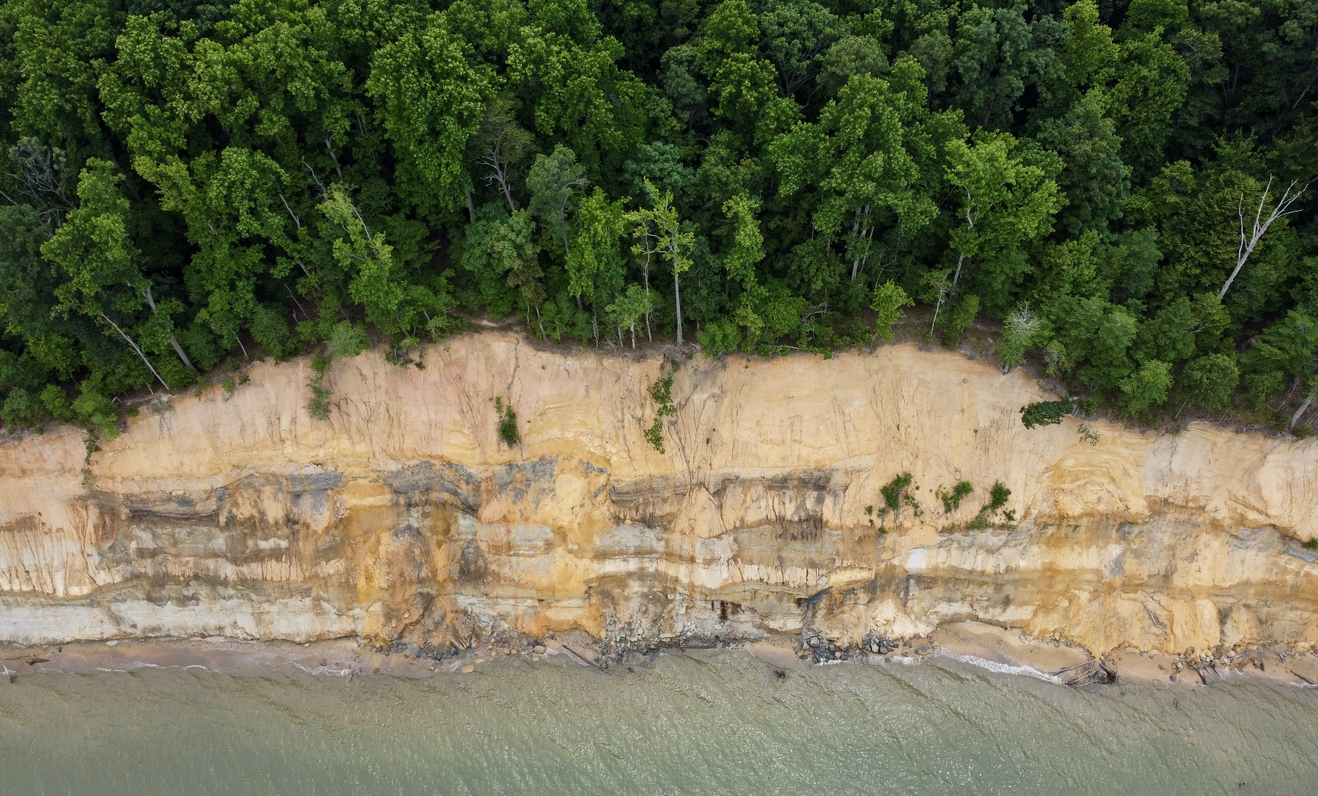
Calvert Cliffs State Park, Maryland
Calvert Cliffs: Rock and Fossil Layers - Teacher's Guide
Grades 3-4
This lesson focuses on two main ideas:
- Using fossils to paint a picture of Earth’s prehistoric past
- Identifying the rock layers where fossils are found, to compare their ages
Procedure
INTRODUCTION (15 minutes)
Read the introduction to students and review the new vocabulary. Students will watch a segment of the “Maryland by Air” video. After the video, discuss the essential questions and thinking questions aligned to the topic and video. Discuss the career connections related to fossils and rock layers with students.
EXTENSION (15-30 minutes)
Complete extension activities with students, as you see fit.
ASSESSMENT (15 minutes)
Have students apply their newfound knowledge by completing a Summative CER on the lesson using evidence from the video and activities as support.
REFLECTION (10 minutes)
Have students complete a reflection.
Standards
4-ESS1-1 Earth's Place in the Universe
Identify evidence from patterns in rock formations and fossils in rock layers to support an explanation for changes in a landscape over time.
- Science and Engineering Practices
Constructing Explanations and Designing Solutions
Constructing explanations and designing solutions in 3–5 builds on K–2 experiences and progresses to the use of evidence in constructing explanations that specify variables that describe and predict phenomena and in designing multiple solutions to design problems.- Identify the evidence that supports particular points in an explanation.
- Disciplinary Core Ideas
ESS1.C: The History of Planet Earth
- Local, regional, and global patterns of rock formations reveal changes over time due to earth forces, such as earthquakes. The presence and location of certain fossil types indicate the order in which rock layers were formed.
- Crosscutting Concepts
Patterns
- Patterns can be used as evidence to support an explanation.
MS-ESS1-4 Earth's Place in the Universe
Construct a scientific explanation based on evidence from rock strata for how the geologic time scale is used to organize Earth's 4.6-billion-year-old history.
- Science and Engineering Practices
Constructing Explanations and Designing Solutions
Constructing explanations and designing solutions in 6–8 builds on K–5 experiences and progresses to include constructing explanations and designing solutions supported by multiple sources of evidence consistent with scientific ideas, principles, and theories.- Construct a scientific explanation based on valid and reliable evidence obtained from sources (including the students’ own experiments) and the assumption that theories and laws that describe the natural world operate today as they did in the past and will continue to do so in the future.
- Disciplinary Core Ideas
ESS1.C: The History of Planet Earth
- The geologic time scale interpreted from rock strata provides a way to organize Earth’s history. Analyses of rock strata and the fossil record provide only relative dates, not an absolute scale.
- Crosscutting Concepts
Scale, Proportion, and Quantity
- Time, space, and energy phenomena can be observed at various scales using models to study systems that are too large or too small.
Standard 2
Human Dependence on Earth Systems and Natural Resources:
Environmentally literate students construct and apply understanding of how Earth’s systems and natural resources support human existence.
Summative CER
Option 1:
Construct an explanation that describes how fossils can be used to better understand what Earth looked like in the past. Use evidence and reasoning from the video and activities to support your response.
Option 2:
Construct an explanation that addresses how scientists can compare the ages of fossils based on the location of the rock layers on a cliffside. Use evidence and reasoning from the video and activities to support your response.
Reflection Questions
- What did Maryland and the Calvert Cliff area look like in the past, based on the dolphin and shellfish fossils found in the cliffside?
- How do scientists compare the ages of fossils based on the location of the rock layers on a cliffside?
Summative CER Rubric
| No Response Score Point 0 |
Not There Yet Score Point 0.5 |
Beginning To Score Point 0.75 |
Yes Score Point 1.0 |
|---|---|---|---|
| The claim is missing | The claim is incorrect or irrelevant. | The claim partially takes a position on the topic or issue addressed within the prompt. | The claim takes an appropriate position on the topic or issue addressed within the prompt. |
| There is no type of evidence in the response | The evidence is irrelevant or does not support the claim. | The evidence partially supports the claim and demonstrates some understanding of the topic or text, using appropriate sources. | The evidence supports the claim and demonstrates a strong understanding of the topic or text, using appropriate sources. |
| There is no use of words, phrases, and clauses to create cohesion and to clarify the relationship between the claim and evidence. | Use of words, phrases and clauses fail to show or explain any relationship between the claim and evidence. | Scientific words, phrases, and clauses used lack cohesion but partially clarify the relationship between the claim and evidence. | Appropriate scientific words, phrases, and clauses are used to create cohesion and to clarify the relationship between the claim and evidence. |